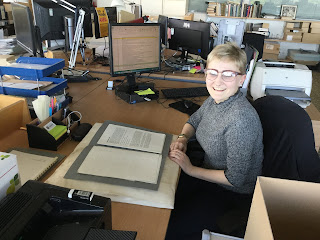This week, we hear from from Employ.ed on Campus intern, Carmen Hesketh, following her first week with LHSA. Employ.ed on Campus is a scheme for current students of the University of Edinburgh offering paid work experience in a variety of exciting projects throughout the University, including here in the Centre for Research Collections!
My name is Carmen and I will be working for the next 10
weeks on the collection of bio-engineer David Gow here at Lothian Health
Services Archive (LHSA).
 |
| Carmen hard at work already! |
I am a third year History student here at the University of
Edinburgh, and since I began my studies I have tried my best to be actively
involved in heritage work in this beautiful city. I began volunteering with
LHSA at the end of my first year and have worked on a variety of projects,
including recording Victorian mental health patient cases from the Royal Edinburgh Hospital; cataloguing oral history projects relating to HIV and AIDS
in Edinburgh during the 1980s; and cataloguing collections related to family
planning and sex education in the 1970s. These projects, along with my
volunteering role at The Royal College of Physicians of Edinburgh where I
transcribed oral history interviews of prominent post-war doctors, has made me
realise that I am passionate about medical and disability history, which has
influenced my academic study. For example, next year I plan on writing my
undergraduate dissertation on how museum collections represent the history of
HIV and AIDS in Scotland. This is one of the many reasons why I am delighted to
have the chance to do this internship with LHSA - I am getting the chance to
develop my knowledge on a research area that I am extremely enthusiastic about,
as well as having the opportunity to create an online resource to make such an
important topic known to the public.
As well as working with medical
collections, I have also been involved in heritage outreach through my job at
The Museum on the Mound where I give presentations on the history of money to
schoolchildren and through a previous internship helping to coordinate Doors
Open Days, Scotland’s largest free architectural heritage festival. Heritage
education is something that I have always loved being a part of and I think
that this internship will be fantastic in helping me further improve my skills
in this area.
Over the next few weeks, I will be examining the collection
donated to LHSA by Dr David Gow. This collection contains records from the
Bio-engineering Centre, which was a department located in the Princess Margaret
Rose Orthopaedic Hospital, opened in the 1960s in order to cater to the needs of
children who suffered from severe limb deficiencies as a result of the
Thalidomide tragedy. Initially, bio-engineers at the Centre, led by Dr (later
Professor) David Simpson, were pioneers in pneumatic powered prostheses – they
created prostheses which were powered by gas and air because batteries at the
time were too heavy to be used as a power source for artificial limbs. They
served around 60 children who needed upper limb prostheses and supported them
until young adulthood, and as well as creating upper limb prostheses. They also
invented aids which could support patients in their daily lives: the most
notable example being the Simpson-Edinburgh Low Pressure Airbed which was
developed in the 1970s and effectively prevented pressure sores for those with
disabilities.
 |
| Professor Simpson's Low Pressure Air-bed |
Dr David Gow was appointed Director of the Centre in 1986, and shifted
from pneumatic powered devices to develop electrically powered prostheses
because he believed that they were more user-friendly and convenient. In 1998,
Dr Gow and his team created and fitted the first complete electrically powered
arm prosthesis, known as the Edinburgh Modular Arm System (EMAS), and in 2007,
he created the i-limb, the first prosthetic hand to have independently powered
articulating fingers. It will be my job to create an online resource about a
variety of themes relating to the collection, cataloguing items relating to the
collection on the University’s online database, and interview Dr David Gow
himself to create an oral history testimony about his contribution to the
field.
 |
| Examples of prostheses (note finger sleeves on top image) created by the Bio-engineering Centre |
Since researching the collection, I have been fascinated by
how much impact the Bio-engineering Centre in Edinburgh has had on patients all
over the world, and how Edinburgh bio-engineers have actively created equipment as
well as prostheses to make life easier for their patients. I am also excited to
meet Dr Gow personally and have the opportunity to interview him about his
thought processes and inspirations for creating a device that is so invaluable
to its users. Overall, I can’t wait to see what the next few weeks have in
store!

No comments:
Post a Comment